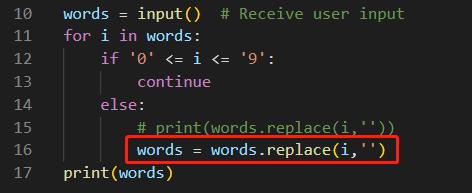Introduction
replace() is the temporary replacement of the "method" of the string return type, whereas reverse() is the inversion of the list permanent system type.
Suppose we have the following code in Python:
words = input() # Receive user input
for i in words:
if '0' <= i <= '9':
continue
else:
print(words.replace(i,''))
print(words)If we input "Hello_2022", we will not get "2022", but in fact replace() is a return method (which is temporary), so the whole loop will not change the value of words, and the output will still be "Hello_2022".
The fix
If we want to fix this bug to get a substitute value, Var assignment can be used. It should be noted that Null (empty) is also a valid "character", otherwise the above operation may cause some issue.

words = words.replace(i,'')It might be a bit hard to understand, but in fact the 'for' operation itself may be more interesting; because in Python, there is the concept of 'iteration'.
reverse()
reverse() is used to reverse combined data types, for example lists, but sadly strings don't have this property (since strings can not be modified after value being assigned). But strings can be reversed by relying on the classic "slicing operation", [::]:
words = input() # Receive user input
words = words[::-1] # Use the double ':', not single ':'
print(words)
listed = [1, 2, 3]
listed.reverse()
print(listed)







Comments 13 comments
test
DinoGame.app offers an exceptional platform for both new and veteran gamers. Whether you’re looking to relive fond memories or discover the Dino Game for the first time, DinoGame.app provides a captivating and accessible experience that’s bound to delight. Dive in today and experience the thrill of the Dino Game like never before!https://dinogame121.amebaownd.com
88CLB là nhà cái vinh dự nhận được giấy phép hoạt động từ Isle of Man Gambling Supervision Commission, tổ chức giám sát cá cược uy tín hàng đầu trên thế giới. 88CLB được biết đến như một trong những doanh nghiệp giàu kinh nghiệm trong ngành giải trí trực tuyến ở châu Á, với gần 20 năm hoạt động. Với sự hỗ trợ vững chắc về tài chính từ Wincapital, thương hiệu này không ngừng phát triển và mở rộng bộ sưu tập trò chơi đa dạng để thỏa mãn nhu cầu ngày càng tăng của khách hàng https://88clb.luxury/
Game bai doi thuong la loai hinh giai tri, ca cuoc truc tuyen duoc yeu thich nhat, dac biet la gioi dan choi dai gia. Hien nay tren thi truong, cac cong game doi thuong moc len nhu nam. website: https://choigamebai.org/
The comment is private
The comment is private
The comment is private
"Website: https://jun88da.com/
The comment is private
Welcome to DinoGame.app, your ultimate destination for playing the beloved Dino game even when you’re offline
The comment is private
The comment is private
Sunwin chính thức cập nhật thêm domain chính hãng sunwin20a.com. Sunwin tặng code tân thủ 199k trong T1 mừng sự kiện ra mắt domain mới tại sunwin20a.com